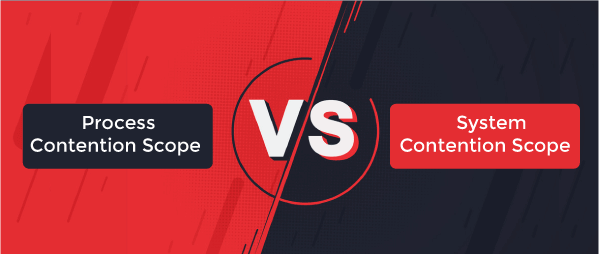Difference between Process Contention Scope and System Contention Scope
In this article, you will learn the difference between the Process Contention Scope (PCS) and System Contention Scope (SCS). But before discussing the differences, you must know about the Process Contention Scope and System Contention Scope.
What is Process Contention Scope?
In an operating system, a kernel thread is scheduled by the OS and controlled by a thread library for user-level threads to run off an available lightweight process. Process contention scope (PCS) is executed by the priority level, which means that the scheduler selects or checks the thread with the highest priority to run first.
The programmer specifies the user-level thread priorities and is not modified by the thread library. There are also various thread libraries that allow the programmer to adjust a thread's priority.
What is System Contention Scope?
It is one of the two thread scheduling schemes available in an operating system. The kernel uses this strategy to determine which kernel-level thread should be scheduled into the CPU. It uses system contention scope, which means that all threads in the system compete for the CPU. It is commonly known as the scope of system contention.
Threads are scheduled using only the system contention scope in systems that use the one-to-one approach, such as Windows, Solaris, and Linux.
Main differences between the Process Contention Scope and System Contention Scope

Here, you will learn the main differences between the Process Contention Scope and System Contention Scope. Various differences between the Process Contention Scope and System Contention Scope are as follows:
- Process contention scope is generally known as local scheduling on unbound threads. On the other hand, system contention scope is generally known as global scheduling on bound threads.
- In the context of process contention scope, there is competition for CPU use amongst threads that are equal to processes. On the other hand, in the context of system contention scope, there is a competition for CPU use that occurs among all threads in an operating system.
- In the context of process contention scope, the thread library has complete control over which user-level thread is to be scheduled on a lightweight process. On the other hand, in the context of system contention, the operating system provides kernel-level threads, in which the kernel determines which threads should be scheduled into a CPU.
- Many-to-many and many-to-one models are used in the process contention scope. On the other hand, the system contention scope uses a one-to-one model.
- Process contention scope or local contention scope refers to a user-level thread that shares a kernel thread with other user threads within the process. On the other hand, the system contention scope is also known as global contention scope, is a user thread directly mapped to one kernel thread.
- Process contention scope is less expensive than the system contention scope. On the other hand, the system contention scope is highly predictable due to the high processing cost.
- Thread shares one or more accessible lightweight processes within the process contention scope. On the other hand, the system contention scope threads share independent lightweight processes.
- Process Contention Scope is used in the Windows, Solaris, and Linux threads. On the other hand, System Contention Scope is used in the Linux threads.
Head-to-head comparison between the Process Contention Scope and System Contention Scope
Here, you will learn the head-to-head comparison between the Process Contention Scope and System Contention Scope. Various head-to-head comparisons between the process contention scope and system contention scope are as follows:
| Process Contention Scope |
System Contention Scope |
| It is commonly known as local scheduling. |
It is commonly known as global scheduling. |
| It used many-to-many and many-to-one models. |
It used only a one-to-one model. |
| It is less expensive than the system contention scope. |
It is highly predictable due to the high processing cost. |
| It is used in the Windows, Solaris, and Linux threads. |
It is used in Linux threads. |
| Thread shares one or more accessible lightweight processes within the process contention scope. |
Its threads share independent, lightweight processes. |
| The thread library has complete control over which user-level thread is to be scheduled on a lightweight process. |
The operating system offers kernel-level threads, in which the kernel determines which threads should be scheduled into a CPU. |
| There is a competition for CPU use amongst threads that are equal to processes. |
There is a competition for CPU use that occurs among all threads in an OS. |
| It refers to a user-level thread that shares a kernel thread with other user threads within the process. |
It is a user thread that is directly mapped to one kernel thread. |
| It uses N : 1 thread model relationship. |
It uses a 1 : 1 thread model relationship with a kernel thread. |
Conclusion
Both process contention scope (PCS) and system contention scope (SCS) are thread scheduling. The process contention scope executes the many-to-one and many-to-many threads. On the other hand, the system contention scope executes only one-to-one threads.
|

 For Videos Join Our Youtube Channel: Join Now
For Videos Join Our Youtube Channel: Join Now










